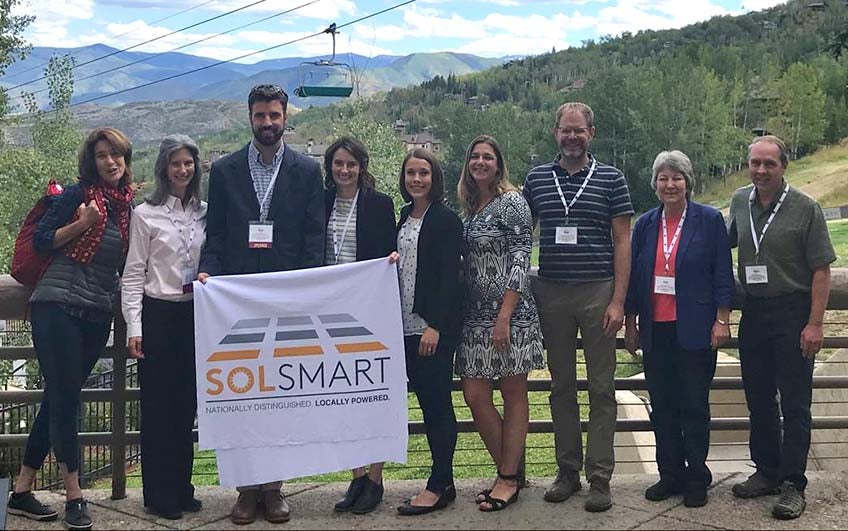
The National Renewable Energy Laboratory (NREL) has assisted the SolSmart program with achieving an impressive milestone in reducing soft costs, providing expert knowledge, and offering resources to communities within the United States that are interested in successfully adopting solar energy into their cities, counties, and regional organizations.
SolSmart’s original goal was to assist at least 300 local governments by October 2020 in making solar energy possible by removing barriers to solar market development. Not only has SolSmart surpassed that goal, but the program has done so before the project’s five-year anticipated end date. NREL has played a major role in streamlining solar power for local governments, and so far has been the direct lead for 78 of the SolSmart-designated communities and has supported SolSmart advisers (program staff temporarily embedded within local governments or regional organizations) in an additional 70 communities. Currently, 42 states have SolSmart-designated communities.
The SolSmart Goal
There are two main thrusts of the SolSmart program, one of which is to designate communities. The three designations are Bronze, Silver, and Gold, and there are a variety of ways for a community to earn the requisite points for each level. Planning and zoning are key elements of the program—to go from one level to the next, a community must make substantial progress in those categories. Permitting and inspection are additional crucial areas. The SolSmart website has presentations and additional resources that walk new audiences through areas of solar growth.
The second part of the SolSmart program involves providing local governments with expertise through technical assistance. Every community joins the program at a different level and with different challenges. Some places, such as San Francisco, have already done a lot of work in the solar market and do not need as much support adopting foundational best practices. In fact, these communities are often the source of best practices that other communities emulate. For some of these more advanced solar communities, NREL adapts to their needs by providing higher-level assistance, such as a PV or storage feasibility analysis. Other places that are new to the solar market need more foundational support, usually with a focus on reducing soft costs.
Regardless of a community’s specific needs, NREL uses its expertise to help each community that it works with streamline their processes. “At NREL, we’ve been focusing on the things that cities and counties can impact, like permitting, zoning, demonstration projects, outreach, and education,” says NREL researcher Jason Coughlin.
Community Engagement
NREL also engages with communities through conferences and webinars to educate them on the benefits of joining SolSmart. NREL Senior Urban and Regional Planner Megan Day organized, moderated, and led a panel session called “Planning and Zoning for Solar—Colorado approachesPDF,” highlighting the findings from more than 20 zoning code reviews for Colorado communities at the APA Colorado 2019 Conference on Sept. 19. Also at this conference, Day presented data and tools for regional solar energy planning.
Communities face many barriers when it comes to streamlining solar growth. Megan Day explains that sometimes the biggest barrier for communities wanting to implement solar is silence in the local zoning code, which means the code does not mention solar at all. This ambiguity can be challenging for someone looking to put solar in a community, because they do not know the exact limitations or restrictions. Alternatively, some communities prefer very strict regulations for solar development, and NREL works with communities across this spectrum to share solar best practices and implementation strategies. Best practices reflected in SolSmart criteria include clearly defining solar energy systems in local zoning codes and allowing rooftop PV systems that meet certain standards as a preapproved use.
Bringing Successful Solar Energy to Market
Soft costs are essentially nonhardware costs—permitting falls into this category. One best practice that NREL encourages for permitting is turning around a permit in three days. By reducing the permitting process timeline, homeowners, installers, and local governments all save money. Reducing soft costs also involves reducing how much time the city’s labor spends on a project. To help with this, NREL is helping communities move toward online permitting for smaller- and medium-sized systems.
A crucial aspect of the SolSmart program is the peer-to-peer strategy. Often, NREL connects communities that have been using solar energy for a long time with communities that are new to it. For example, several SolSmart communities in rural Indiana are concerned about large-scale PV development on farmland. These communities are interested in using pollinator-friendly vegetation for reseeding after installing a solar farm. NREL connected the communities in Indiana with a county in Minnesota that has gone through a similar situation and developed best practices. Building a network of solar energy communities has been an extremely useful development within the program.
The combination of designating communities, providing expert technical assistance, and connecting local governments means that NREL can help push communities to achieve strong, local solar markets. “One of the biggest impacts of the program is having a structure that allows local governments to tap into NREL’s expertise on some of these pressing solar issues they’re facing, so they can move forward in a particular area. Access to this kind of knowledge and support is really invaluable,” says Alexandra Aznar, SolSmart project manager for NREL.
SolSmart’s impact was recently recognized at Solar Power International in September when the program received a National 3iAward for best state and local government initiative of 2019 by the Interstate Renewable Energy Council.


